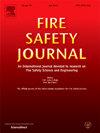消防泡沫的台架尺度和大尺度消光指标之间的相关性
IF 3.4
3区 工程技术
Q2 ENGINEERING, CIVIL
引用次数: 0
摘要
计算了 MIL-PRF-24385 1.8 米直径水池灭火结果与各种 19 厘米水池灭火指标之间的局部加权回归(LWR),这些指标已汇编到最近的数据库中。目标:确定台架实验和大规模泡沫灭火实验之间的相关性,以改进台架实验,更快速地筛选环保型泡沫的灭火潜力。工作台规模指标包括灭火时间与泡沫流速曲线的曲线下面积(AUC)、泡沫流速范围内的平均灭火时间,以及通过池火上方的可调二极管激光吸收光谱(TDLAS)测量确定的二氧化碳灭火时间。当在 LWR 算法中实施交叉验证时,AUC 值、基于二氧化碳的消光时间以及流速为 1500 毫升/分钟的消光时间与大规模数据的相关性最好;但是,R2 值均低于 0.6,表明相关性较低。虽然主动式与被动式消防员和泡沫生成方法之间存在差异,但数据准确性和有限的数据可能是造成 R2 值低的最大原因。尽管辐射强度和与大型火灾相关的湍流会减弱,但 LWR 的相关性还是很有希望的,并且可以通过准确的数据得到改善,从而为台架规模测试提供信心。本文章由计算机程序翻译,如有差异,请以英文原文为准。
Correlations between bench-scale and large-scale extinction metrics for firefighting foams
Locally weighted regressions (LWR) were calculated between MIL-PRF-24385 1.8 m diameter pool fire extinction results and various 19 cm pool fire metrics, as compiled in a recent database. The goal: to define correlations between bench and large-scale foam fire extinction experiments to improve bench-scale experiments to more rapidly screen the firefighting potential of environmentally-friendly foams. Bench-scale metrics included the area under the curve (AUC) for extinction time versus foam flow rate profiles, the average extinction times at binned foam flow rate ranges, and CO2-based extinction times, determined through tunable diode laser absorption spectroscopy (TDLAS) measurements above the pool fire. When cross-validation was implemented within the LWR algorithm, the AUC values, CO2-based extinction times, and extinction times for a flow rate-bin >1500 ml/min showed the best correlations to large-scale data; however, the R2 values were all below 0.6, indicating a low level of correlation. Although differences between active versus passive firefighter and foam generation methods exist between the two scales, data accuracy and limited data are likely contributing the most to low R2 values. The LWR correlations are promising and can be improved with accurate data, providing confidence in bench-scale testing despite diminished radiation intensity and turbulence associated with larger fires.
求助全文
通过发布文献求助,成功后即可免费获取论文全文。
去求助
来源期刊

Fire Safety Journal
工程技术-材料科学:综合
CiteScore
5.70
自引率
9.70%
发文量
153
审稿时长
60 days
期刊介绍:
Fire Safety Journal is the leading publication dealing with all aspects of fire safety engineering. Its scope is purposefully wide, as it is deemed important to encourage papers from all sources within this multidisciplinary subject, thus providing a forum for its further development as a distinct engineering discipline. This is an essential step towards gaining a status equal to that enjoyed by the other engineering disciplines.
 求助内容:
求助内容: 应助结果提醒方式:
应助结果提醒方式:


